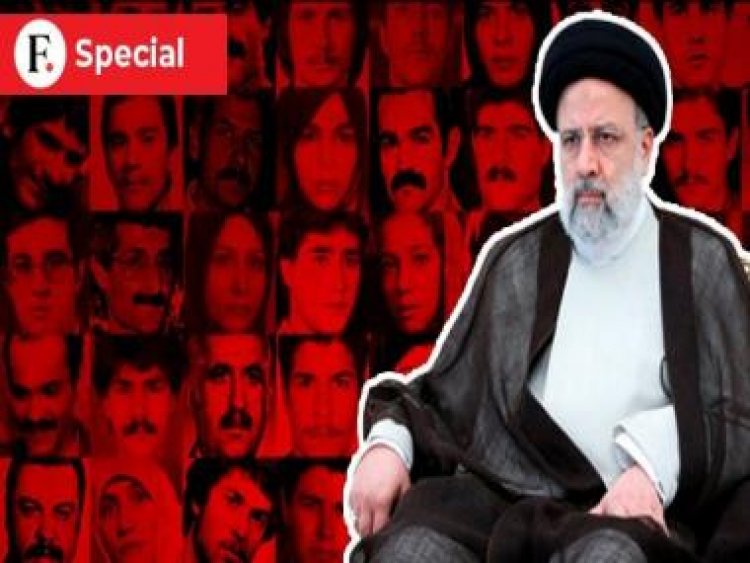Iran's biggest serial killer?: A look at president Ebrahim Raisi's role in 1988 massacre of thousands of prisoners
Iran's biggest serial killer?: A look at president Ebrahim Raisi's role in 1988 massacre of thousands of prisoners

On 13 November 2022, Iran issued its first death sentence linked to the ongoing nationwide protests.
This has led rights groups to warn that jailed demonstrations are at risk of being ‘executed.’
According to the not-for-profit Human Rights Activists in Iran, over 15,000 people have been arrested in connection with the demonstrations which began in September following the death of 22-year-old Mahsa Amini after she was arrested by the infamous morality police.
Iran has seen several instances of persecution of prisoners, the bloodiest of which happened in 1988.
One of the four prosecutors who were part of the so-called ‘death commission’ that oversaw the execution of thousands of prisoners that year, Ebrahim Raisi is currently the president of Iran.
The order for the execution of prisoners was directly given by Iran’s first Supreme Leader Ayatollah Khomeini through a ‘secret fatwa’.
Raisi played a prominent role in the massacre which has been dubbed as Iran’s worst both in terms of the deaths and the subsequent cover-up by the authorities.
To date, the Iranian government continues to defend the massacre as the ‘execution of terrorists.’ It has also not revealed the exact number of those killed and victims’ families continue to fight for justice.
According to Khomeini’s deputy Hussein-Ali Montazeri 2,800 to 3,800 inmates were killed but some estimates put the number at 30,000.
Before delving into Raisi’s involvement, let us take a look at how the extrajudicial killings happened and who were the victims.
What happened
According to a 1990 Amnesty International report, the massacre was “premeditated.”
It all started in July 1988. Amnesty said that “thousands of prisoners were suddenly cut off from the outside world.” Jails across Iran stopped family visits & prisoners were denied access to TV and radio.
In the coming days, thousands of prisoners were tortured before being executed on fake charges.
Some dissidents were subjected to enforced disappearance before being killed.
Isolated from the outside world and even their fellow prisoners, several inmates remained unaware of the fate that awaited them.
In Nasser Mohajer’s book, Voices of a Massacre, one of the survivors Mahnaz Saida recalls that the prisoners found out about the execution of an inmate after overhearing the conversation between the Revolutionary Guards members at the jail.
“Not a single one of those called (for interrogation) had returned,” she said.
Who were the prisoners & why were they killed
The prisoners comprised men, women, and children. While some were dissidents, some were religious minorities.
According to Amnesty, many of those jailed were involved in “peaceful activities such as distributing opposition leaflets and attending demonstrations.”
In fact, the prisoners had already served lengthy prison terms.
According to reports, many victims were supporters of the People’s Mojahedin Organization of Iran or the PMOI which tried to overthrow the Islamic Republic in the final stages of the Iran-Iraq War (1980-88). The Iranian armed forces were able to repulse the attack.
Soon after the military success, officials began hunting down PMOI supporters. But not all belonged to the PMOI.
Prisoners were asked about their political as well as religious affiliations.
“In the “re-trials” they faced, the first group was asked about their political affiliation – those who answered “Mojahedin” were sent to their death. Some were asked if they were willing to clear the minefields for the army of the Islamic Republic. The second group was questioned about their religious faith – again, a wrong answer resulted in a death sentence,” an Amnesty report said.
The killings became public knowledge after prison visits resumed and families flocked to jails to meet their loved ones.
How the public came to know about the killings
According to victims’ relatives, while officials told them about their loved ones’ deaths, the nature of the demise was not revealed.
“The Revolutionary Guards summoned my father to their office… There, he was taken into a room and sat on a chair. An official then walked in, put a bag on his desk and said: ‘Here is your son’s bag; we have executed him. Now take his stuff and get out.” Amnesty quoted Jafar La’li whose brother Jamshid La’li was executed as saying.
Several families were misled by prison officials and found out about the killings through former inmates.
Many don’t even know where their loved ones were buried.
Raisi defends his role in the massacre
This brings us to Raisi’s role. At the time of the massacre, Raisi was the Deputy Prosecutor of Tehran. He was part of the ‘death commission’ that ruled whether prisoners should be executed or not, an Iran Human Rights report said.
After becoming the president of Iran in 2021, Raisi defended his role in the executions.
“Those who make accusations, it should be said that today we are the accusers as defenders of human rights. All the measures I took during my posts were always in defense of human rights against those who disrupted the rights of humans,” Iran Human Rights quoted him as saying.
Raisi even added that he should be “commended for defending the rights of the people.”
Meanwhile, victims’ families and human rights groups continue to battle for justice both at the domestic and international levels.
In January 2022, over 450 former United Nations judges and investigators called on the UN human rights organisation to open a probe into the 1988 and also Raisi’s role.
Read all the Latest News, Trending News, Cricket News, Bollywood News,
India News and Entertainment News here. Follow us on Facebook, Twitter and Instagram.
What's Your Reaction?

























































